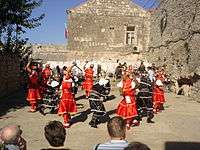Korčula (town)
| Korčula | |
|---|---|
| Town | |
|
Korčula Old Town | |
 Korčula Location of Korčula within Croatia | |
| Coordinates: 42°57′0″N 17°07′30″E / 42.95000°N 17.12500°ECoordinates: 42°57′0″N 17°07′30″E / 42.95000°N 17.12500°E | |
| Country |
|
| County |
|
| Island | Korčula |
| Government | |
| • Mayor | Vinko Kapelina (HDZ) |
| Population (2011)[1] | |
| • Town | 5,663 |
| • Urban | 2,856 |
| Time zone | CET (UTC+1) |
| • Summer (DST) | CEST (UTC+2) |
| Postal code | 20260 |
| Area code(s) | +385 20 |
| Vehicle registration | DU |
| Website | korcula.hr |
Korčula (Italian: Curzola) is a historic fortified town on the protected east coast of the island of Korčula, in Croatia, in the Adriatic.
Population
The City of Korčula has a total population of 5,634, in the following individual settlements:[1]
- Čara (Chiara), population 616
- Korčula (Curzola), population 2,856
- Pupnat (Pupnata), population 391
- Račišće, population 432
- Žrnovo (Zernova), population 1,368
Construction
The old city is surrounded by walls, and the streets are arranged in a herringbone pattern allowing free circulation of air but protecting against strong winds.[2] Korčula is tightly built on a promontory that guards the narrow sound between the island and the mainland. Building outside the walls was forbidden until the 18th century, and the wooden drawbridge was only replaced in 1863. All of Korčula's narrow streets are stepped with the notable exception of the street running alongside the southeastern wall. The street is called the Street of Thoughts as one did not have to worry about the steps.
Historic sites
The town's historic sites include the central Romanesque-Gothic Cathedral of St Mark (built from 1301 to 1806), the 15th-century Franciscan monastery with a beautiful Venetian Gothic cloister, the civic council chambers, the palace of the former Venetian governors, grand 15th- and 16th-century palaces of the local merchant nobles, and the massive city fortifications.
Cursola, as it was called in Latin, became an episcopal see in the early 14th century, when the bishop of Ston (Stagnum in Latin) asked to be authorized to transfer his seat there because of Serb pressure on Ston. This was granted and he was made bishop also of a new diocese of Cursola united with his previous one. In 1541, the Ragusans asked for the separation of ecclesiastical jurisdiction over Ston, which they had conquered, from Cursola, which in the previous century had become a Venetian possession. In 1828, when both the Korčula and Ragusa (Dubrovnik) belonged to the Austrian Empire, the territory of the diocese of Cursola was made part of that of Dubrovnik.[3][4][5] No longer a residential bishopric, Cursola is today listed by the Catholic Church as a titular see.[6]
Culture
The devout Catholic inhabitants of Korčula keep alive old folk church ceremonies and a weapon dance, the Moreška, which dates back to the Middle Ages.[7] Originally danced only on special occasions, in modern times there are performances twice a week for tourists.[8]
The city's Town Statute [9] dating back to 1214 prohibited slavery.[10][11]
Gallery
 Church of Saint Nicholas
Church of Saint Nicholas Town walls at dawn
Town walls at dawn View of the town
View of the town Moreška
Moreška Sunset at Korčula
Sunset at Korčula Korčula town walls
Korčula town walls Panorama view of Korčula
Panorama view of Korčula
References
- 1 2 "Population by Age and Sex, by Settlements, 2011 Census: Korčula". Census of Population, Households and Dwellings 2011. Zagreb: Croatian Bureau of Statistics. December 2012.
- ↑ Architecture Korčula-www.korculainfo.com
- ↑ Curzola, in Dictionnaire d'Histoire et de Géographie ecclésiastiques, vol. XIII, Paris 1956, coll. 1116-1117
- ↑ Konrad Eubel, Hierarchia Catholica Medii Aevi, vol. 1, pp. 462-463; vol. 2, p. 241; vol. 3, p. 183; vol. 4, p. 170; vol. 5, p. 178; vol. 6, pp. 189-190
- ↑ Pius Bonifacius Gams, Series episcoporum Ecclesiae Catholicae, Leipzig 1931, p. 405
- ↑ Annuario Pontificio 2013 (Libreria Editrice Vaticana 2013 ISBN 978-88-209-9070-1), p. 878
- ↑ The Early Korčula Moreska Journal article by Max Harris, Lada Cale Feldman; Comparative Drama, Vol. 37, 2003
- ↑ Dunin, Elsie Ivancich, ed. (2006). Korčulanska Moreska (in Croatian).
- ↑ Korčula Statute-www.korculainfo.com
- ↑ Footprint Croatia-Page 289 Jane Foster
- ↑ "Razvitak hrvatskih otoka" (PDF). Građevinar (in Croatian). 52 (6). 2000. Retrieved 14 February 2015.
External links
- Korculainfo.com
- The official web site of Korčula(Croatian)(English)
